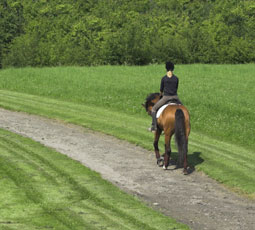 |
| Long, slow rides at the walk are essential for rebuilding your horse’s base fitness after some time off. |
Most of us are unable to ride consistently all year round, whether due to excessively hot or cold climates or a layoff period resulting from an injury. Assuming your horse has access to turnout or some light hand-walking or longeing during the off season, giving him some time to relax and unwind will make him happier when he does come back into work.
So how do you safely prepare your horse for his eventual return to intense trail rides, jumping or a full show schedule? Here are some tips to follow, no matter what type of riding you pursue.
These Hooves Were Made for Walking
Experts on conditioning almost universally recommend long, slow distance work. So be prepared to spend a lot of time going for long walks. If your horse has been completely out of work for months, his tendons and ligaments will require much more time to get fit than his cardiovascular system will, and the best way to do this is by walking under saddle for up to an hour per day, four to six days per week. Stick to walking for at least the first two weeks of your program; you can gradually increase the time and/or add hill work to keep things challenging, always keeping a feel for when your horse starts to get tired.
“If you run through a set of time limits without listening to the horse’s fatigue level, you’ll injure your horse,” says Chris Newton, DVM, of Rood & Riddle Equine Hospital in Lexington, Ky. Newton specializes in equine sports medicine, field practice, reproduction and alternative therapies. In addition, he competes in eventing, show jumping and dressage, while serving on multiple boards to help organize and further equestrian sport in Kentucky. “I like to get the horses out for one to two hours a few times a week for very slow work, which is still muscularly intense, so that I can feel where fatigue enters the picture for that individual horse.”
The Need for Speed
After two weeks, you can gradually add in a few minutes of trotting. Take walk breaks after 2 or 3 minutes of trotting when you start, then work up to 5 to 10 minutes of trot over the next week as your horse is able.
In week four, you can add 1 to 2 minutes of cantering, building up from there. After 30 days, you can introduce a few small jumps or very short bursts of more intense work as your discipline requires.
After six weeks of consistent work, your horse should be much closer to optimum fitness. Throughout his conditioning period and beyond, continue walking as much as possible each day; this can be done before and after the more intense portion of your ride. Tendons and ligaments take months to get stronger.
“Muscles become more rapidly conditioned, and the heart is a muscle that is constantly working and is the most adaptable muscle to conditioning,” says Newton. “The last focus of your routine should be cardiovascular work. Horses will get aerobic conditioning while trotting. If you want to work on anaerobic training, then you can canter, but you need to do so slowly.”
Other factors to consider include the individual horse, as well as his breed. Hotter types, such as Thoroughbreds, will be ready to gallop endlessly straight off a layup, but this doesn’t mean you should let them. Drafts and heavier-type horses often need to be coaxed through their fitness routine at first, but as they get fitter, they will offer to keep up their pace more willingly.
While young horses benefit most from time off, the opposite becomes true as the horse ages. “Older horses (for these purposes, over 10 years of age) tend to do worse off an extended layoff just as older people would,” says Newton. “Every time you have to regain an older horse’s base fitness, you increase the likelihood of injury. Maintaining a constant base on older horses is important.”
Location, Location, Location
Fitness can be achieved anywhere there is safe footing, but you and your horse may grow bored making endless laps around an indoor arena all winter. If your horse is barefoot or shod in snow pads, you can hack around the farm even when there’s snow on the ground. Once spring weather debuts, you can take a friend and go for a long walk on the trail. Conditioning can be good for both the body and the mind!
Holly Caccamise is the managing editor of Horse Illustrated. She received her M.S. in animal science with a specialization in equine nutrition and exercise physiology.






Great tips for horse and rider alike.